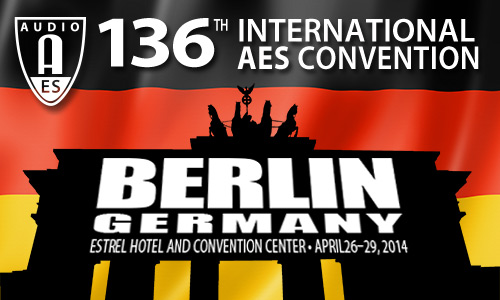
AES Berlin 2014
Paper Session P8
P8 - Transducers—Part 2
Monday, April 28, 13:30 — 16:00 (Room Paris)
Chair:
Hans Riekehof-Boehmer, SCHOEPS Mikrofone - Karlsruhe, Germany
P8-1 Ambient Atmospheric Conditions and Their Influence on Acoustic Measurements—Peter John Chapman, Bang & Olufsen a/s - Struer, Denmark
The paper describes an area that is often not considered by those who are involved in performing acoustic measurements. Specifically, the measured sound pressure level is directly influenced by the ambient atmospheric conditions in which the measurement is performed and by the raw condition of the device under test. The influence of temperature, atmospheric pressure, and humidity are described. Different strategies for removing these influences are presented. Furthermore, consequences of ignoring these influences in the laboratory and on the production line are illustrated in terms of measurement error, falling yield, and misalignment of sensitivity in active systems. The paper focuses on indoor acoustic measurements but the subject is equally valid for outdoor measurements.
Convention Paper 9061 (Purchase now)
P8-2 Numerical Simulation of Microphone Wind Noise, Part 3: Wind Screens and Shields—Juha Backman, Nokia Corporation - Espoo, Finland
This paper discusses the use of the computational fluid dynamics (CFD) for computational analysis of microphone wind noise. This final part of the study discusses the effect of typical wind shields and pop screens on the flow around the microphone body. The simulations show that although all types of screens share common action mechanisms, moving the vortices generated by the flow further away from the microphone diaphragm and absorbing the vortex energy, the importance of these mechanisms varies with the type and size of the shield. In addition to the flow properties also the effect of different wind shields on the acoustical response of the microphone is discussed.
Convention Paper 9062 (Purchase now)
P8-3 Graphene Microphone—Dejan Todorovic, Dirigent Acoustics Ltd. - Belgrade, Serbia; Iva Salom, Institute Mihajlo Pupin - Belgrade, Serbia; Djordje Jovanovic, Institute of Physics Belgrade, University of Belgrade - Belgrade, Serbia; Aleksandar Matkovic, University of Belgrade - Belgrade, Serbia; Marijana Milicevic, University of Belgrade - Belgrade, Serbia; Mirjana Radosavljevic, Dirigent Acoustics Ltd. - Belgrade, Serbia
This paper analyses recent trends in graphene research and applications in acoustics and audio-technology and attempts to identify future directions in which the field is likely to develop. The possibilities of application of single or multi-layer graphene as membranes in transducers are the scope of the research of the graphene group. FEM and experimental analysis of single and multi-layer graphene, as well as realization of the first samples of acoustic transducers, are in progress.
Convention Paper 9063 (Purchase now)
P8-4 How Far Do Microphones Reach? A Comparison between Dynamic and Analog / Digital Condenser Microphones—Jürgen Breitlow, Georg Neumann Berlin - Berlin, Germany; Dominic Haul, Georg Neumann Berlin - Berlin, Germany
The feedback of recording engineers to condenser microphones occasionally refers to them as “hearing too far.” Unwanted background noises such as fans, clocks, air conditioners that are not heard when recording with a dynamic microphone are being reproduced by a condenser microphone. In the present study this phenomenon is examined in regard to its physical cause. The whole signal chain from the microphone to the recorder has to be considered. Therefore it needs to be determined how the masking effect and the perceptibility of quiet sources are influenced by the self-noise of the signal chain.
Convention Paper 9064 (Purchase now)
P8-5 A Condenser Microphone for Close-Miking and Very High Sound Pressure Levels–Revisited—Martin Schneider, Georg Neumann GmbH - Berlin, Germany
In the late 1960s, tube condenser microphones were superseded by their transistorized counterparts. Close-miking was adopted for pop and rock music. Microphones able to handle these very high SPLs, but keeping the familiar sonic characteristics, needed to be developed. One model, that has now become a classic of its own, will be described in detail, taking advantage of well-sorted archives and the original documents.
Convention Paper 9065 (Purchase now)
